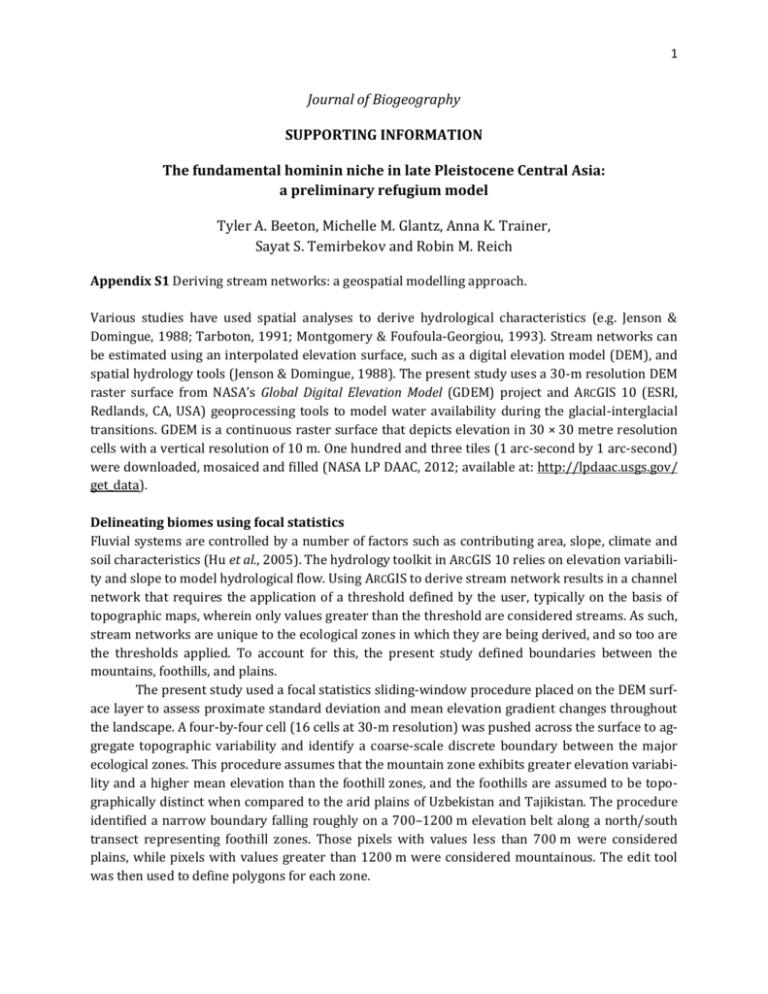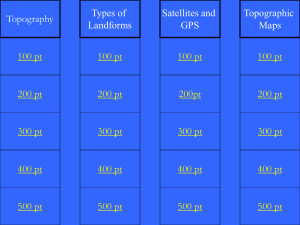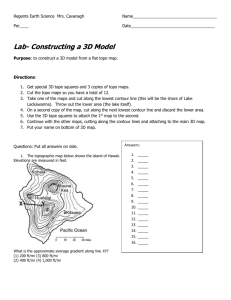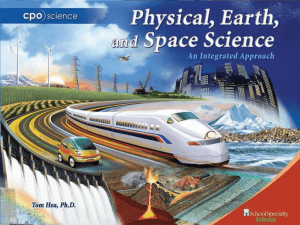jbi12183-sup-0001-AppendixS1
advertisement

1 Journal of Biogeography SUPPORTING INFORMATION The fundamental hominin niche in late Pleistocene Central Asia: a preliminary refugium model Tyler A. Beeton, Michelle M. Glantz, Anna K. Trainer, Sayat S. Temirbekov and Robin M. Reich Appendix S1 Deriving stream networks: a geospatial modelling approach. Various studies have used spatial analyses to derive hydrological characteristics (e.g. Jenson & Domingue, 1988; Tarboton, 1991; Montgomery & Foufoula-Georgiou, 1993). Stream networks can be estimated using an interpolated elevation surface, such as a digital elevation model (DEM), and spatial hydrology tools (Jenson & Domingue, 1988). The present study uses a 30-m resolution DEM raster surface from NASA’s Global Digital Elevation Model (GDEM) project and ARCGIS 10 (ESRI, Redlands, CA, USA) geoprocessing tools to model water availability during the glacial-interglacial transitions. GDEM is a continuous raster surface that depicts elevation in 30 × 30 metre resolution cells with a vertical resolution of 10 m. One hundred and three tiles (1 arc-second by 1 arc-second) were downloaded, mosaiced and filled (NASA LP DAAC, 2012; available at: http://lpdaac.usgs.gov/ get_data). Delineating biomes using focal statistics Fluvial systems are controlled by a number of factors such as contributing area, slope, climate and soil characteristics (Hu et al., 2005). The hydrology toolkit in ARCGIS 10 relies on elevation variability and slope to model hydrological flow. Using ARCGIS to derive stream network results in a channel network that requires the application of a threshold defined by the user, typically on the basis of topographic maps, wherein only values greater than the threshold are considered streams. As such, stream networks are unique to the ecological zones in which they are being derived, and so too are the thresholds applied. To account for this, the present study defined boundaries between the mountains, foothills, and plains. The present study used a focal statistics sliding-window procedure placed on the DEM surface layer to assess proximate standard deviation and mean elevation gradient changes throughout the landscape. A four-by-four cell (16 cells at 30-m resolution) was pushed across the surface to aggregate topographic variability and identify a coarse-scale discrete boundary between the major ecological zones. This procedure assumes that the mountain zone exhibits greater elevation variability and a higher mean elevation than the foothill zones, and the foothills are assumed to be topographically distinct when compared to the arid plains of Uzbekistan and Tajikistan. The procedure identified a narrow boundary falling roughly on a 700–1200 m elevation belt along a north/south transect representing foothill zones. Those pixels with values less than 700 m were considered plains, while pixels with values greater than 1200 m were considered mountainous. The edit tool was then used to define polygons for each zone. 2 Stream network derivation A flow direction (FD) raster is the initial input surface required to carry out any of the operations nested in the hydrology toolkit. It creates a raster depicting the direction of flow from each cell to its steepest down-slope neighbour (Jenson & Domingue, 1988). The flow accumulation (FA) tool provides a raster output which identifies the total number of cells that flow into any given cell (Jenson & Domingue, 1988). Derived from the FD layer, the FA output is a rudimentary stream network representing values from 0 (no flow accumulation) to infinity, depending on the topography of the study area. For example, points along high order rivers such as the Syr Darya, which transects Kyrgyzstan, Tajikistan and Kazakhstan, exhibit FA values in the millions. However, not all values in the FA output represent a stream, and it is necessary at this step to apply a threshold to eliminate ephemeral streams and other ‘noise’ from the model. The present study used georectified topographic maps (1 : 100,000 scale) and 3-D ARCGLOBE geovisualization techniques to determine a threshold representing the minimum contributing area needed to support a stream network in the foothills and mountains. Water availability near sites on the plains was digitized using georectified topographic maps. Twenty FA sample units were extracted from individual biomes. These sample units were then overlain on topographic maps and satellite imagery in three-dimensional space. Two thresholds were identified for each zone to model water access during glacial and interglacial periods. A few issues should be mentioned in relation to the method. The contemporary climate of Central Asia is warmer and drier than any other period during the late Pleistocene (Forster & Heller, 1994; Ding & Ding, 2003; Herzschuh, 2006); the reliance on contemporary hydrography for model building may therefore result in an underestimate of water availability during interglacial periods and an overestimate during glacial periods. Other lines of evidence support the notion that contemporary ecosystems are most similar to those of the initial stages of OIS 3 (Dodonov et al., 2000; Rupper, 2007). Therefore, the present study used contemporary topographical maps to determine the threshold for interglacial periods. During glacial periods water availability would have been severely diminished (Hewitt, 2004) and previous research using GIS modelling techniques has considered only third order streams and above as accessible water resources during glacial advances (Field et al., 2007). Strahler’s stream order index (1957) was used to determine the threshold for glacial periods. A simple conditional statement in the raster calculator eliminated all streams below the third order. We measured the distance (km) from each archaeological site to the stream networks using a leastcost path (LCP) analysis. LCP analyses are preferred over straight line measurements due to their ability to incorporate costs to dispersal. In this study, slope was identified as an impediment to dispersal. Model evaluation The hydrology model presented here is based solely on topographic variability. As such, it is necessary to test whether the topographic variability observed in each biome coincides with the observed variability in the sample units used to derive the model. Landform indices derived from McNab (1993) and the curvature tool set in ARCGIS is one way to characterize landscape variability. The landform index identifies three major classifications: convex ridges, flat slopes and concave depressions. The primary output demarcates the curvature of the surface of an individual cell while taking 3 into consideration the eight nearest neighbours surrounding an individual cell (McNab, 1989). A positive curvature indicates that the surface is upwardly convex at that cell, a negative curvature denotes a concave surface, and a value of 0 indicates the surface is flat. Expected values range from −4.0 to +4.0. A curvature operation was applied to the study extent, clipped to each biome, and reclassified into five classes: very concave, concave, flat, convex and very convex. The proportion of each class was calculated using the field calculator and cell statistics in the attribute table to characterize the variability within the mountain and foothill zones. Next, the layer was extracted to a 2-km buffer around the sample units used to derive thresholds for the model. The proportion of each class was compared between the sample units and their respective biome using a chi-square test. Although both groups are significantly different due to misrepresentation of the extremes, the sample units adequately capture the other classes and we feel that the sample units offer a robust representation of topographic variability. REFERENCES Ding, F. & Ding, Z. (2003) Chemical weathering history of the southern Tajikistan loess and paleoclimate implications. Science in China D: Earth Sciences, 46, 1012–1021. Dodonov, A.E., Tchepalyga, A.L., Mihailescu, C.D., Zhou, L.P., Markova, A.K., Trubikhin, V.M., Simakova, A.N. & Konikov, E.G. (2000) Last-interglacial records from central Asia to the northern Black Sea shoreline: stratigraphy and correlation. Netherlands Journal of Geosciences, 79, 303–311. Field, J.S., Petraglia, M. & Lahr, M.M. (2007) The southern dispersal hypothesis and the South Asian archaeological record: examination of dispersal routes through GIS analysis. Journal of Anthropological Archaeology, 26, 88–108. Forster, T. & Heller, F. (1994) Loess deposits from the Tajik depression (Central Asia): magnetic properties and paleoclimate. Earth and Planetary Science Letters, 128, 501–512. Herzschuh, U. (2006) Palaeo-moisture evolution in monsoonal Central Asia during the last 50,000 years. Quaternary Science Reviews, 25, 163–178. Hewitt, K. (2004) Geomorphic hazards in mountain environments. Mountain geomorphology (ed. by P. Owens and O. Slaymaker), pp. 187–218. Hodder Scientific, London. Hu, Q., Willson, G.D., Chen, X. & Akyuz, A. (2005) Effects of climate and landcover change on stream discharge in the Ozark Highlands, USA. Environmental Modeling and Assessment, 10, 9–19. Jenson, S.K. & Domingue, J.O. (1988) Extracting topographic structure from digital elevation data for geographic information system analysis. Photogrammetric Engineering and Remote Sensing, 54, 1593–1600. McNab, W.H. (1989) Terrain shape index: quantifying effect of minor landforms on tree height. Forest Science, 35, 91–104. McNab, W.H. (1993) A topographic index to quantify the effect of mesoscale landform on site productivity. Canadian Journal of Forest Research, 23, 1100–1107. Montgomery, D.R. & Foufoula-Georgiou, E. (1993) Channel network source representation using digital elevation models. Water Resources Research, 29, 3925–3934. NASA Land Processes Distributed Active Archive Center (LP DAAC) (2012) ASTER L1B. USGS/ Earth Resources Observation and Science (EROS) Center, Sioux Falls, SD. Rupper, S.B. (2007) Glacier sensitivity and regional climate: past and present. PhD Thesis, University of Washington, Seattle, WA. Strahler, A.N. (1957) Quantitative analysis of watershed geomorphology. Transactions of the American Geophysical Union, 38, 913–920. Tarboton, D.G., Bras, R.L., Rodriguez-Iturbe, I. (1991) On the extraction of channel networks from digital elevation data. Hydrological Processes, 5, 81– 100.







